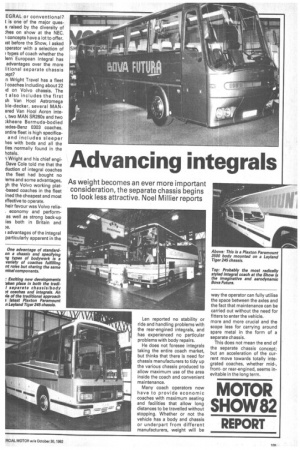Advancing integrals
Page 61

If you've noticed an error in this article please click here to report it so we can fix it.
EGRAL or conventional? I is one of the major gues s raised by the diversity of ;hes on show at the NEC. ) concepts have a lot to offer. 1st before the Show, I asked )perator with a selection of types of coach whether the lern' European integral has advantages over the more litional separate chassis :ept?
n Wright Travel has a fleet ?coaches including about 22 td on Volvo chassis. The t also includes the first sh Van Hod l Astromega ble-decker, several MANered Van Hod Acron inte;, two MAN SR280s and two ;kheere Bermuda-bodied ;edes-Benz 0303 coaches. entire fleet is high specifica and includes sleeper hes with beds and all the ties normally found in the hotels.
Wright and his chief engiDave Cole told me that the duction of integral coaches the fleet had bought no lems and some advantages, gh the Volvo working plat-based coaches in the fleet ined the cheapest and most 3ffective to operate.
heir favour was Volvo relia, economy and performas well as strong back-up ies both in Britain and )e.
advantages of the integral particularly apparent in the Len reported no stability or ride and handling problems with the rear-engined integrals, and has experienced no particular problems with body repairs.
He does not foresee integrals taking the entire coach market, but thinks that there is need for chassis manufacturers to tidy up the various chassis produced to allow maximum use of the area inside the coach and convenient maintenance.
Many coach operators now have to provide economic coaches with maximum seating and facilities that allow long distances to be travelled without stopping. Whether or not the vehicle has a body and chassis or underpart from different manufacturers, weight will be way the operator can fully utilise the space between the axles and the fact that maintenance can be carried out without the need for fitters to enter the vehicle.
more and more crucial and the scope less for carrying around spare metal in the form of a separate chassis.
This does not mean the end of the separate chassis concept; but an acceleration of the current move towards totally integrated coaches, whether mid-, frontor rear-engined, seems inevitable in the long term.






































































